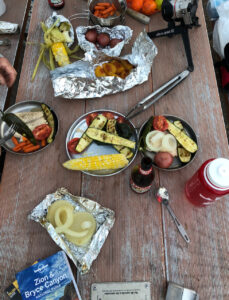
I love cooking at home, the process of putting together a meal out of ingredients is a rewarding creative outlet. It’s even better as an excuse to see and hang out with friends and you should approach camping in the same way–as a dinner party outdoors. This guide assumes you can haul everything from your house or the grocery store in a car. If you’re backpacking, check out this version.
When cooking and eating outdoors, you should leverage the strengths of your environment: access to fire, and scenery. Overall, your meal should be similar to a meal you’d make at home: a protein, vegetable, and starch/carbs. If you are with new campers who are maybe less comfortable with the outdoors, a luxe meal is a great way to highlight the positives of being outside and sleeping on the ground. If you are with a big group, doling out prep work can be a great way to occupy your friends and will create lasting memories. Since you have plenty of room in your car, don’t be afraid to bring real plates and silverware. The contrast of eating surf and turf with cloth napkins, a tablecloth, and a few bottles of good red wine on a picnic bench is really fun.
Rather than list specific recipes, I’ll highlight a few ingredients, tools, and methods that work well in a camp.
Ingredients
- Proteins: Big things that won’t fall through a grill, like thick steaks, chicken pieces, or a lamb roast. Lobster tails can also work if you get the timing right and don’t overcook them.
- Vegetables: Same idea. Asparagus works as long as you have them perpendicular to the grille, bell peppers if on a low heat, corn takes forever but can be great, portobello mushrooms, Brussels sprouts in a pan.
- Starch: Potatoes are great. Bread can be quickly heated up on the fire right before you eat, or nestled in foil on the side of the fire as long as you don’t forget about or burn it.
- Spices and other stuff: A high-heat refined oil like avocado, or vegetable oil that can stand up to grill temperatures. Olive oil is probably not that useful over a fire, although you will want something for salad dressing. A little quiver of spices starting with salt and pepper, some sort of Cajun blend can be versatile, a dried blend of poultry herbs (thyme, rosemary, sage), garlic powder. Butter and bacon improve most foods and need minimal refrigeration, and bacon can do double duty as a source of fat for cooking.
Tools
- A cast iron skillet will heat up slowly and evenly, which is useful over a fire. It also should not need too much scrubbing to clean, and looks the part. It will be useful for making breakfast, cooking sides like Brussels sprouts (and keeping them hot while something else cooks), and unlike your All-Clad stainless, you will not feel bad about putting it directly on the fire. I have this giant one from Cabela’s which has held together an epic sausage and egg scramble for 10 hungover guys on a bachelor party and hosted a dozen mini potatoes along with rosemary garlic and salt for a side dish, among other things. Avoid acidic foods like tomatoes in cast iron, as they will taste metallic.
- A long handled set of tongs and a normal set (these from Williams-Sonoma are sturdy and worth it) are useful for handling things on the grill and checking the doneness of meat. Get ones that are all metal and won’t melt, and that have a good bite–you want to avoid dropping your dinner in ashes and dirt.
- Aluminum foil is useful for protecting food from the temperature extremes of cooking over a fire (like the cast iron). Get the heavy duty kind.
Method
Jacques Pepin’s La Technique is a good place to start but a few camping specific tips:
Lamb roasts and whole chicken (and turkey) take forever to cook over a fire but are immensely rewarding. Plan for them to sit for several hours over medium heat, because unlike in an oven, they are not surrounded by heat on all sides. Wrap in a few layers of foil and rotate them every so often so that the meat is evenly cooked and not burned, when it gets less squishy finish over high heat to crisp the outside. Steaks are probably easiest, don’t forget to let it rest for a few minutes while you reheat the sides if needed and plate them. Aim for a little more rare than you think and then you would at home, you’ll be fine and it is more authentic.
Pretty much all vegetables should be grilled, corn can take forever also so be careful if you are relying on them for your side. If it’s something that will fall through the grills, then throw them in your hot cast iron skillet that already has a fat in it.